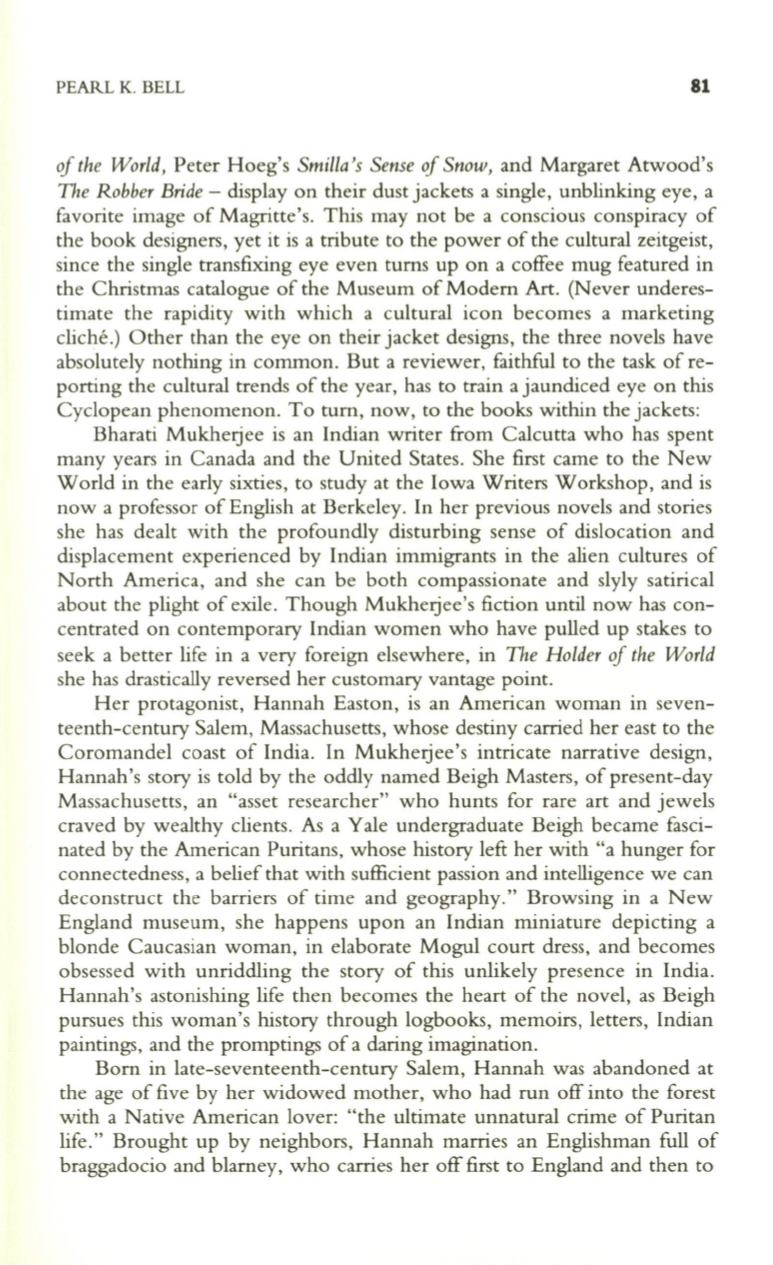
PEARL K. BELL
81
of the World,
Peter Hoeg's
Smilla's Sense of Snow,
and Margaret Atwood's
The Robber Bride
-
display on their dust jackets a single, unblinking eye, a
favorite image of Magritte's. This may not be a conscious conspiracy of
the book designers, yet it is a tribute to the power of the cultural zeitgeist,
since the single transfixing eye even turns up on a coffee mug featured in
the Christmas catalogue of the Museum of Modem Art. (Never underes–
timate the rapidity with which a cultural icon becomes a marketing
cliche.) Other than the eye on their jacket designs, the three novels have
absolutely nothing in common. But a reviewer, faithful to the task of re–
porting the cultural trends of the year, has to train a jaundiced eye on this
Cyclopean phenomenon. To tum, now, to the books within the jackets:
Bharati Mukheijee is an Indian writer from Calcutta who has spent
many years in Canada and the United States. She first came to the New
World in the early sixties, to study at the Iowa Writers Workshop, and is
now a professor of English at Berkeley. In her previous novels and stories
she has dealt with the profoundly disturbing sense of dislocation and
displacement experienced by Indian immigrants in the alien cultures of
North America, and she can be both compassionate and slyly satirical
about the plight of exile. Though Mukheijee's fiction until now has con–
centrated on contemporary Indian women who have pulled up stakes to
seek a better life in a very foreign elsewhere, in
The Holder of the World
she has drastically reversed her customary vantage point.
Her protagonist, Hannah Easton, is an American woman in seven–
teenth-century Salem, Massachusetts, whose destiny carried her east to the
Coromandel coast of India. In Mukherjee's intricate narrative design,
Hannah's story is told by the oddly named Beigh Masters, of present-day
Massachusetts, an "asset researcher" who hunts for rare art and jewels
craved by wealthy clients. As a Yale undergraduate Beigh became fasci–
nated by the American Puritans, whose history left her with "a hunger for
connectedness, a belief that with sufficient passion and intelligence we can
deconstruct the barriers of time and geography." Browsing in a New
England museum, she happens upon an Indian miniature depicting a
blonde Caucasian woman, in elaborate Mogul court dress, and becomes
obsessed with unriddling the story of this unlikely presence in India.
Hannah's astonishing life then becomes the heart of the novel, as Beigh
pursues this woman's history through logbooks, memoirs, letters, Indian
paintings, and the promptings of a daring imagination.
Born in late-seventeenth-century Salem, Hannah was abandoned at
the age of five by her widowed mother, who had run off into the forest
with a Native American lover: "the ultimate unnatural crime of Puritan
life." Brought up by neighbors, Hannah marries an Englishman full of
braggadocio and blarney, who carries her off first to England and then to


